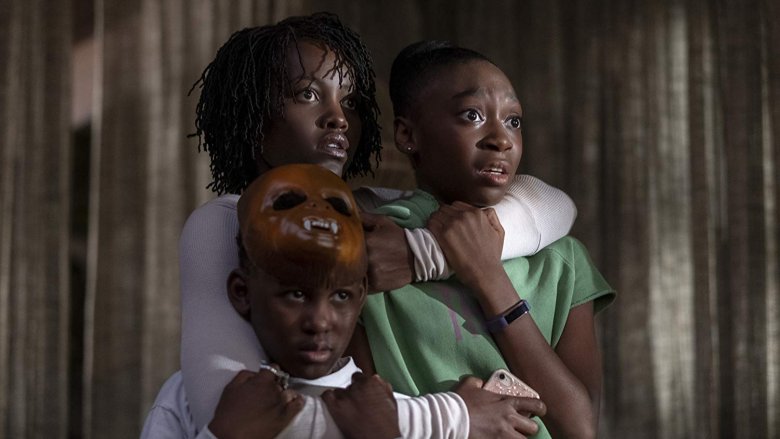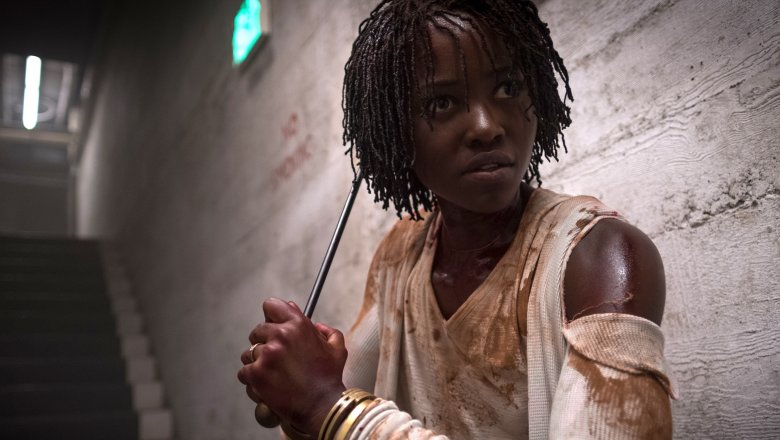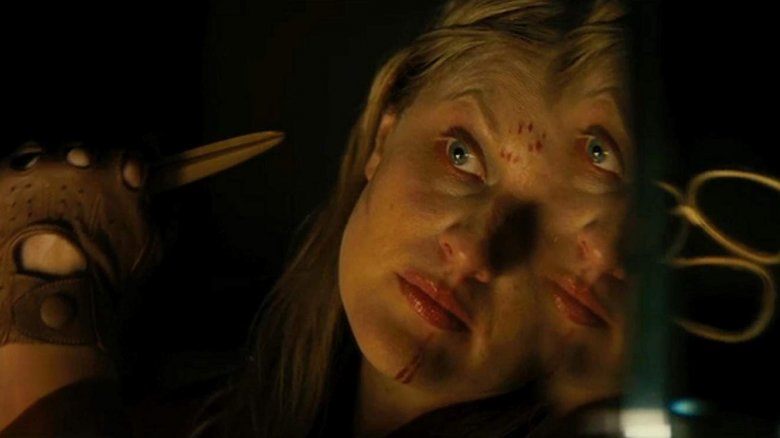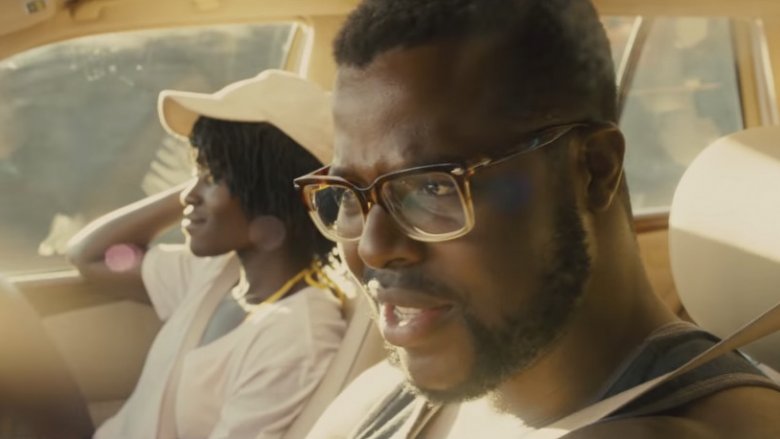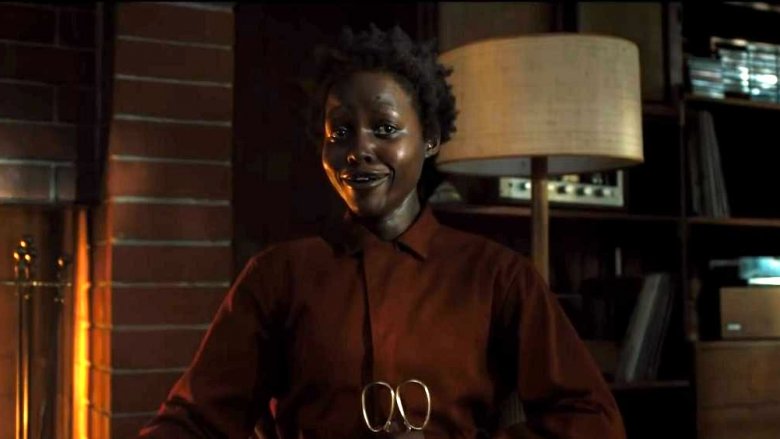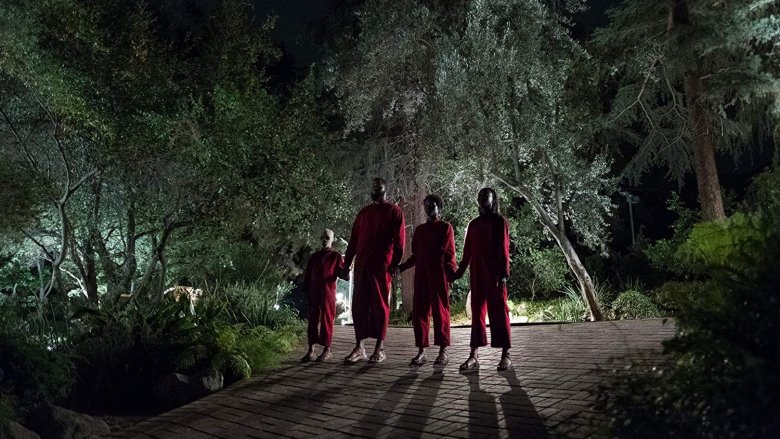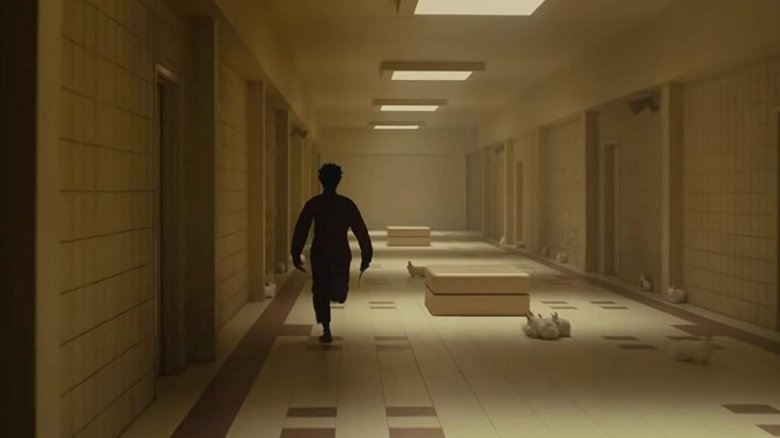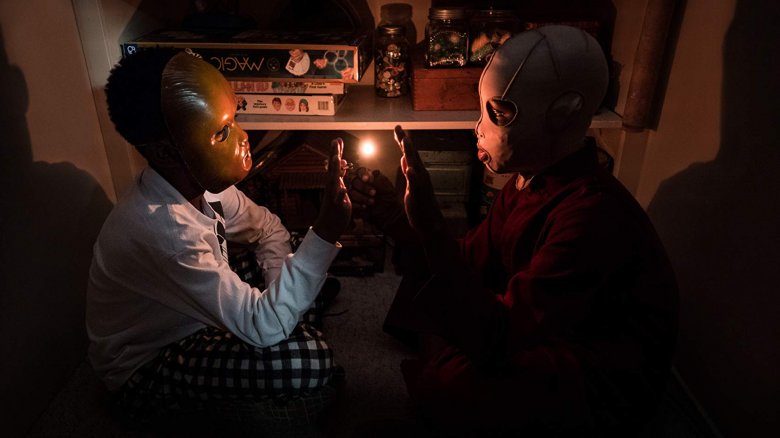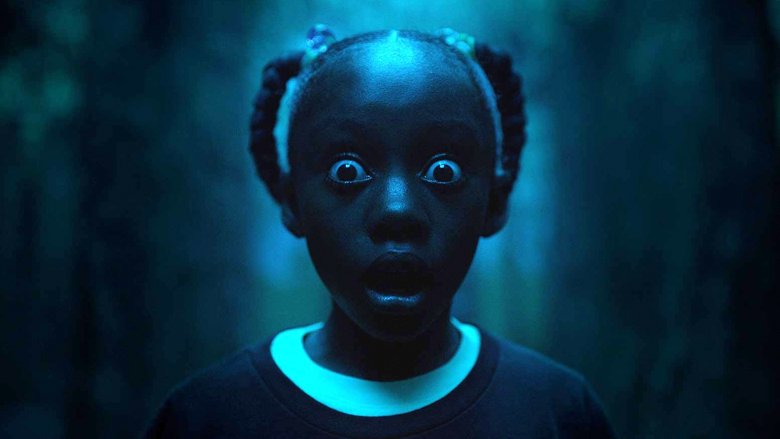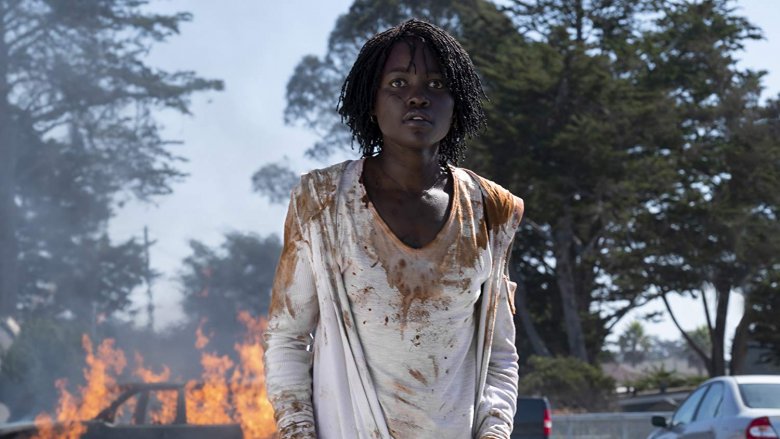The 5 Best And 5 Worst Things About Us
Us, writer/director Jordan Peele's much-anticipated follow-up to his horror masterpiece Get Out, is finally here, and it was worth the wait. The film has garnered rave reviews for its writing, stylish direction, performances, and blend of comedy and horror, but it's more than just a fun theatrical ride. Packed with high-concept payoffs and twists, Us is also the kind of film that will keep you thinking for days and even weeks after you've left the theater.
What starts as an apparently simple home invasion fright fest quickly evolves into something bigger, as Peele spins bigger and bigger ideas into a movie with bigger and bigger implications. The result is a conceptually weighty horror film that keeps you guessing and keeps you thinking right up to the very last scene, and that means we've got plenty to talk about — so with that in mind, here are the five best and five worst things about Us.
Note: Sometimes we talk about "five best and five worst" things in terms of "five good things and five bad things," but there's almost nothing bad about this movie. So let's think of this less in terms of good and bad and more in terms of "five favorite and five least favorite." Deal? Deal.
Oh, and it should go without saying, but there are SPOILERS AHEAD for the entire movie. You've been warned.
Best: Lupita Nyong'o
Horror cinema has a huge capacity for pushing actors to their emotional and physical limits, and the genre's long tradition of placing vulnerable women at the center of stories means we've gotten truly legendary performances out of some major talents, from Jamie Lee Curtis to Sigourney Weaver to Toni Collette.
Lupita Nyong'o's Adelaide is the emotional, thematic, and logistical center of Us, and she rises to the occasion by adding another legendary performance to the history of horror films, a performance made all the more powerful by her dual roles. As Adelaide she is vulnerable but strong, scared but determined, loving but savage. As Red, Adelaide's Tethered double, she is both an entirely different personality and every bit Adelaide's mirror image. She jerks and twists when Adelaide is graceful, grins when Adelaide gasps in terror, and croaks where Adelaide speaks. It's a magnificent pair of performances that makes Nyong'o Oscar-worthy yet again in her still-young career, and while there are certainly plenty of other things to recommend about Us, her daring and brilliant performance is the first thing many moviegoers will come away talking about.
Worst: The Tylers
Horror films are often at their best when they take broad archetypal characters and concepts and present them to us in new ways. It's why sex-crazed teenagers are often at the heart of slasher movies, and haunted house films almost always feature some variant of the steadfast Skeptic character. The films root themselves in the familiar in big, easy to notice ways so that when the unfamiliar starts to happen, we're still rooted to the reality of the movie.
Sometimes, though, the familiar archetypes don't quite land as well as they perhaps should, and this is at least somewhat true of the Tyler family in Us. They're presented as shallow, bickering people with no real sense of love between them, and while that creates plenty of opportunities for comedy, it does mean the blow is dulled a little bit when their murders happen midway through. Yes, that sequence is funny and gets quite tense when the Wilsons show up, but you get the sense that the Tylers didn't really need to be as broad as they are, particularly when the film already roots us in the emotional reality of the Wilsons. Then again, the black family surviving through sheer practical determination while the dumb white family dies instantly is a wonderful juxtaposition you don't see in horror films that often, so maybe it was worth it.
Best: The comedy
Long before he was an acclaimed genius of the horror genre, Jordan Peele was an acclaimed genius of the comedy genre, thanks to his TV series Key & Peele, his film Keanu (both with friend and collaborator Keegan-Michael Key), and more. Peele never made some kind of hard cut from one genre to the other, though, and as a horror fan he has an innate understanding of the role comedy plays in scary movies, something he demonstrated over and over again with his debut horror feature, Get Out.
Us is another masterclass in balancing laughs and scares, beginning with the interplay of the Wilson family as they travel together in the car and continuing throughout the entire film. Like his horror, Peele's comedy starts small, with little Dad jokes from Gabe (Winston Duke) and comforting family banter. It continues to build from there until it's intertwining with the scares, as Gabe wrestles with his Tethered double on his new boat. Ultimately, in the most desperate situations in the film, the comedy provides a welcome sense of meta fun, as the Wilson family can't help commenting on how bizarre their situation is even as they're trying to survive it. All of that, plus a welcome needle drop from NWA, means that Us is often as hilarious as it is terrifying.
Worst: A grab bag of metaphors
Us begins with what seems like a relatively tight concept, even if that concept could go in any number of ways in terms of theme. Then the film expands, and expands, and keeps expanding until it essentially has worldwide implications, and the themes just keep expanding with it.
Because of that expansion, Us gets messy, and not just in terms of the body count. The film swells until it becomes not just about our own dark sides, but about how some people prosper while others suffer in an unfair system, and about how the powerful manipulate regular people in myriad unseen ways, and about empty gestures of charity and hope that are mostly about public relations, and about the lengths we'll go to in order to take what we feel we deserve, and so on, and so on.
It's not that these aren't valid themes, or that they can't co-exist. It's that by the end, the film tries to throw these things at us all at once, and that means some of them land hard to the point that they stick in your brain for days and some simply fall by the wayside. It's a shotgun approach to the allegory at the heart of the movie, and it doesn't work as well it should. It could even be said that, without Get Out to compare it to, we wouldn't notice the difference, but it's there, and it's noticeable. Still, the ambition is commendable.
Best: The Tethered
Us is Jordan Peele's first opportunity on the big screen to construct his own version of a classic movie monster. Yes, there are villains in Get Out, but the entire point is that they just look like prominent, nice-on-the-surface white people. With this film, Peele gets to craft truly creepy nightmares called the Tethered, and they live up to all the promise they had in the film's trailers.
The design of the Tethered is deceptively simple, and even though we don't learn why they look the way they do — red jumpsuits, gloves, sandals, and scissors — until late in the film, their look works from the very beginning, when we see them standing in the Wilson family's driveway, silent and stoic.
As the concept at the heart of the film continues to expand, and its mythology gets more complex, the Tethered themselves remain deceptively simple movie monsters. Their behavior can change a bit and their motives can become more clear, but the deliberate, almost robotic way in which they pursue their goals does not, and that makes them terrifying, particularly when the Tethered invade the Tyler home. They're extremely effective movie monsters thanks in part to Peele's less-is-more approach, and the actors inhabiting them make them unforgettable slasher villains.
Worst: The execution of that big reveal
As the film's final act leads Adelaide down into a series of tunnels, she (and we) finally learn what the Tethered really are: genetic copies of people living on the surface world (two people sharing one soul, as Red puts it), human in body but not entirely in spirit, who were created to serve as underground "puppets" for the powerful to manipulate the citizenry. Of course, that eventually all went wrong, and the Tethered were simply left in the tunnels to fend for themselves, until Red herself began to organize the uprising that we see playing out in the film.
It's an intriguing explanation for a lot of seemingly unrelated things, but the way it's finally revealed to us happens in an at least slightly dull way, by having Red explain it all to Adelaide and to the audience via voiceover. We've seen this villain do all manner of frightening, unpredictable, and compelling things, and now in this moment she's reduced to monologuing in a dark room because the film simply has to dish out a whole bunch of information in a very short time. It's perhaps the one inelegant thing the film has to offer, and it still manages to be interesting even if it is clunky.
Best: The visual style
Peele is such a talented writer — skilled at wielding high concepts in new ways, mixing comedy and drama, and pacing in a way that makes it look easy — that he could shoot his films in a style that's merely competent and still come away with hits. As long as everything's in focus and the editing isn't confusing, the story will still work and the characters will still come through. Peele isn't content to just keep things adequate, though, and that shows through in the visual flourishes present throughout Us.
It starts with that creepy opening sequence, as we follow young Adelaide with a Spielbergian child's eye view of the carnival, and continues into the elegant setups for the home invasion that then pay off spectacularly when the Tethered actually arrive, right down to Red's silhouette as she walks along the family's deck. It then culminates in the underground sequences of the film's climax, which call to mind Day of the Dead with their claustrophobic atmosphere. Each shot is carefully considered, beautifully placed, and cut together with a deliberate and brisk flow. That makes the scares work, of course, but it also serves to remind us that we're in the company of a gifted visual storyteller as well as a gifted writer.
Worst: A flimsy central concept
The eventual explanation for who and what the Tethered really are and why they were created is an intriguing one, and helps to set up that amazing final shot of bloody Hands Across America. The explanation sets up all sorts of interesting metaphorical cul de sacs for the audience's brain to run down, and the film moves at such a brisk pace that we don't spend too much time worrying about the logistics of it all.
That changes a little as the visceral entertainment high from the moviegoing experience starts to fade, and we're left to pick apart the concepts a bit more. The film tells us that Adelaide met her Tethered double in the funhouse because she wandered off, and the Tethered also wandered off, hence the meeting and Adelaide's place as someone special amid this concept. But children wander off all the time. Couldn't the Tethered have broken out into the surface in a bigger way before? Red mentions the Tethered were simply left to fend for themselves at some point, but why would people in power simply leave something like that to chance? Why can the Tethered act with free will in some scenes and become mirror images of their above-ground counterparts the next? There are no doubt explanations for this, but the film is too interested in moving relentlessly forward to give them to us, and that creates a certain amount of skepticism.
Best: The ambition
With Get Out, Peele took a simple horror structure — an outsider encounters a family with a dark secret — and expanded it out into a high concept full of intense allegorical power. With Us, he does it again, as what starts as a strange new take on the home invasion thriller morphs into something much bigger almost immediately. It doesn't take long for the Wilson family to understand that they're wrapped up in something massive, and it doesn't take long for Peele — beginning with Red's claim that she and her cohorts are "Americans" — to pile on big idea after big idea.
What makes Us particularly satisfying in this regard is that Peele was not content to stick to one fairly simple metaphor. This film could have functioned entirely as a home invasion thriller about how our own dark sides and hidden traumas can come back to haunt and harm us, and it probably would have worked. In expanding the film out well beyond that initial, quite scary concept, Peele signals to his audience that he's not content to keep within certain thematic boundaries, that he wants more. What he keeps reaching for might not always stick (more on that later), but the sheer ambition at work here is impressive and compelling all on its own.
Worst: That final twist
Us is less than two hours long. It doesn't give into the modern trend of bloating genre films with a self-important need to expand their concepts and character histories into 2.5-hour behemoths, and the concepts it introduces leave plenty of loose ends for moviegoers to chew on in a mostly pleasant way. That said, it's a lot of movie to pack into two hours. It keeps getting bigger and bigger and bigger, and then when everything seems to be wrapped up, it hits us with something else.
As she drives her family away from Santa Cruz and toward Mexico, Adelaide has a flashback and realizes something shocking: She is actually the original Tethered, and Red was the original Adelaide who she strangled and locked up in the tunnels after that carnival encounter all those years ago. That's why Red talks with a croak, and why she's the only Tethered who talks: She's a once-normal person altered by trauma and a crushed windpipe.
The twist works, because it's the kind of thing that just burrows into your brain as the credits are rolling, but it also feels like the last brick that almost makes the tower beneath it start to topple. If there's one impulse the movie should have resisted, it might be this one, even if it is something the viewer never saw coming.
